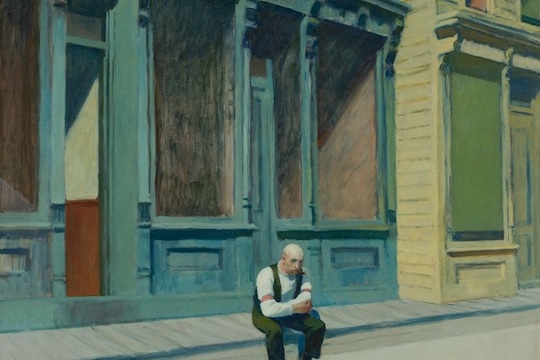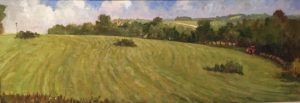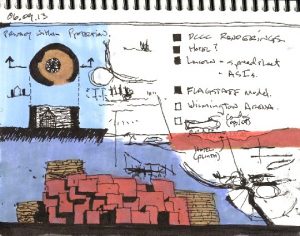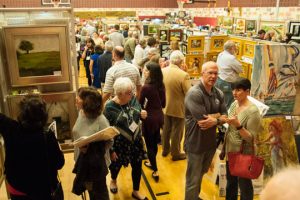Fifty-four paintings by Stuart Davis, Arthur Dove, Thomas Eakins, Marsden Hartley, Childe Hassam, Winslow Homer, Edward Hopper, Jacob Lawrence, Georgia O’Keeffe, Horace Pippin, Maurice Prendergast, John Sloan, and many others that reflect the rich diversity of style and expression in American art created between 1870 and 1950 will be on view at the Brandywine River Museum of Art staring Feb. 25.
“From Homer to Hopper: Experiment and Ingenuity in American Art,” organized by The Phillips Collection in Washington, D.C., traces the course of American modernism in the works of these artists—from the bold, investigative realism of Winslow Homer and Thomas Eakins at the end of the 19th century to the reductive views and psychological insights of Edward Hopper and Morris Graves at mid-20th century.
The Phillips Collection, founded in 1918 by Duncan Phillips and opened in the Phillips family home in 1921, has always championed modernism and the rich diversity of America’s talented artists. Phillips formed his groundbreaking collection with a strong emphasis on works by artists whose critical thinking and creative originality raised American art out of relative obscurity.
He challenged the perceived superiority of European over American art and sought works by women, artists of color, and native and foreign-born artists, as well as those who were self-taught, so that the collection represented a “fusion of various sensitivities” and a “unification of differences” that would parallel the multicultural character of the nation.
The Phillips Collection was the first museum to give living artists solo exhibitions, and Duncan Phillips’s support for American artists through acquisitions, commissions, exhibitions, and financial stipends was a critical factor in the careers of many.

The exhibition presents a thematic chronological journey outlining Duncan Phillips’s broad collecting interests and major developments in American art. In recognition of the important connections between modern artists and the artistic innovators of the past, the exhibition begins with Romanticism and Realism. This section includes late 19th-century artists such as romantic painters George Inness and Albert Pinkham Ryder and innovative realist painters Winslow Homer and Thomas Eakins, whom Phillips viewed as America’s modern “old masters” who looked for alternatives to the prevalent art idioms of their time. A witness to the heroism of mariners along the coast of Maine, Homer succinctly captured man’s universal struggle against nature in works such as “To the Rescue” (1886) by distilling key elements to their most compelling components.
The exhibition “From Homer to Hopper: Experiment and Ingenuity in American Art” provides a unique opportunity to see and experience the stunning range of artistic innovation in the United States between 1850 and 1950. Duncan Phillips was ahead of his time in finding, fostering, and collecting works by artists who were guided by their individual visions rather than popular trends. This exhibition celebrates that achievement and the diversity and innovation of American art.
Impressionism reveals the impact of French Impressionism on Childe Hassam, Theodore Robinson, John Henry Twachtman, and Julian Alden Weir. Adopting the spirit rather than the letter of the French model, American artists took up painting en plein air and applying pure unmixed color in dabs and expressive brushstrokes even as they favored a more silvery palette and a reluctance to dissolve form with color. Their subjects were those of their French counterparts—people at leisure or strolling down elegant city avenues, American life painted with a sparkling sense of light, color, and atmosphere.
In the 20th century, several artists moved away from the influence of Impressionism and its heightened use of light, color, and texture. Forces in Nature presents a new kind of expressive realism in paintings by Rockwell Kent, Marsden Hartley, John Marin, and others who were enthralled by rugged, remote locales untouched by modern civilization. These American modernists chose to explore dramatic and remote landscapes in isolation to convey a personal sense of place through their paintings. They intuitively grasped nature’s raw elemental power and met it head on.
In the aftermath of WWI, another group of American artists looked for meaning through a spiritual interpretation of nature. Nature and Abstraction showcases the works of Arthur Dove, John Marin, and Georgia O’Keeffe, who were among the first wave of artists in the United States to work in a conceptual rather than representational mode of art. Encouraged by photographer and gallerist Alfred Stieglitz and inspired by the theories of Wassily Kandinsky, these American artists pared away surface realism and context, using color, line, and form to express the inner essence of things and their connection with nature. Escaping urban centers for rural New England, Long Island, and the austere desert landscape of New Mexico, these artists distilled landscapes into their basic geometric forms, using emotive color and modulated tones, as in Arthur Dove’s painting “Red Sun” (1935).
Modern Life features works created during the early decades of the 20th century that reflect the impact of industrialization on American life. In their paintings, George Bellows, Guy Pène du Bois, and Edward Hopper delineated a new undercurrent of tension and disquiet in American life. In Sunday (1926), Hopper isolates a shopkeeper on an empty street lined by buildings with vacant windows. His use of acidic colors heightens the sense of dislocation and alienation.
The City presents works by artists who embraced the new face of urban America through its architecture, engineering, and industry. Charles Sheeler, Ralston Crawford, and Stefan Hirsch analyzed and translated structural forms in the urban landscape into abstract precisionist designs.

They abandoned modulated form, preferring to organize their urban imagery into simple lines, flat geometric shapes, and repeating patterns, using neutral tones shocked with red and yellow, and sharp contrasts between black and white to convey the scale, weight, and distance of structures. Eliminating people and nature from their paintings, these American modernists portrayed a dual message about the triumph and eclipse of man in the modern age.
Memory and Ienity brings together works by Horace Pippin, Jacob Lawrence, Yasuo Kuniyoshi, Allan Rohan Crite, and others who painted the unique voice of non-white communities and the immigrant experience in America. Their social realism, a blend of representation and abstraction, vividly captured the physical reality and emotional tenor of the country’s poor and oppressed. A leader in this movement was Jacob Lawrence, whose series “The Life of Toussaint L’Ouverture” (1937-38) — translated into silkscreen prints that appear in this exhibition — were his first works dedicated to the depiction of black life and history.
Awareness of the broadening ethnicity of the country’s population also brought increased attention to American folk traditions in art. The exhibition’s paintings by Doris Lee, John Kane, and Grandma Moses demonstrate their interest in simplified descriptive views that capture the day-to-day rituals of rural and small-town life in America.
Legacy of Cubism highlights artists working in the 1920s and 1930s — Stuart Davis, John Graham, Karl Knaths, George L. K. Morris, and Bradley Walker Tomlin—who identified with the ideals of Cubism. That art movement was born in France and early in the 20th century and burst onto the American scene in 1913 at the Armory Show in New York, stunning the public with its radical reinterpretation of the physical world based completely on geometric form. While repellent to some, the new movement was revelatory to artists who chose to break completely from traditional modes of representation. Freeing themselves from representational styles, American artists braved overt criticism of their experimentation with Cubism’s new ideas about the order and balance of objects in spacer.
In the final section, Degrees of Abstraction, Arthur Dove, Morris Graves, Marsden Hartley, and Theodoros Stamos took abstraction beyond Cubism. They explored ideas about philosophy, mathematics, science, religion, and music as influences for their art. Morris Graves integrated Far Eastern philosophies such as Zen Buddhism and Taoism in brooding metaphorical images of plants, animals, and birds. Arthur Dove bridged the divide between Cubism and representation by keeping recognizable forms embedded within his organic, amorphous shapes.





Comments